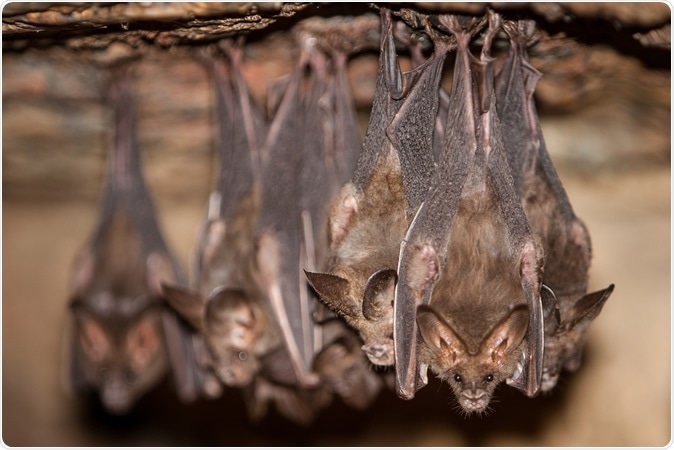For years, several coronaviruses have caused disease among humans. While most of these infections are mild, some coronaviruses have caused deadly outbreaks in the past, including the severe acute respiratory syndrome (SARS) and the Middle East respiratory syndrome (MERS). Now, a new coronavirus, the severe acute respiratory syndrome coronavirus 2 (SARS-CoV-2) that causes coronavirus disease (COVID-19), has brought the world to a standstill.
SARS-CoV-2 infection and COVID-19 disease emerged in Wuhan City, Hubei Province, in China in December 2019 and has spread to nations, placing many cities into lockdown. People are required to stay home in an attempt to curb the pandemic.
While the world grapples with the pandemic, which has spread to 185 countries and territories, infecting more than 2.15 million people and killing more than 143,000 people, a team of researchers at the Smithsonian's Global Health Program has found six novel coronaviruses in bats in Myanmar.

Bats hanging from the ceiling of a cave in the Mergui Archipelago, Myanmar. Image Credit: Ethan Daniels / Shutterstock
Further studies are needed to determine the potential of these coronaviruses to spread in humans and to understand better if they will cause health risks in the future.
The study, published in the journal PLOS ONE, shows these newly discovered coronaviruses are not closely related to the three deadly viruses, SARS-CoV, MERS-CoV, and SARS-CoV-2. The findings shed light on the diversity of coronaviruses in bats. This will help scientists and health officials detect, prevent, and respond to future infectious diseases that may pose a risk to human health.
"Viral pandemics remind us how closely human health is connected to the health of wildlife and the environment. Worldwide, humans are interacting with wildlife with increasing frequency, so the more we understand about these viruses in animals -- what allows them to mutate and how they spread to other species -- the better we can reduce their pandemic potential," Marc Valitutto, a former wildlife veterinarian with the Smithsonian's Global Health Program and lead author of the study, said.
Bats as reservoir
The recent emergence of bat-borne zoonotic viruses that jump to humans warrants vigilant surveillance to reduce the risk of a "spillover" event. The three most recent coronavirus diseases, such as the SARS, MERS, and SARS-CoV-2, show how viruses that often infect animals can be transmitted to humans and cause severe disease.
Bats have strong immune systems that enable them to host pathogens without being infected. The resistance in bats, along with their migratory patterns, makes them significant vectors for carrying and transmitting viruses. Bats are known as carriers for coronaviruses, a family of viruses that cause gastrointestinal and respiratory diseases in mammals, birds, and even humans. Bats are also the source of filoviruses, such as the Ebola virus.
Six novel coronaviruses found in bats https://www.news-medical.net/news/20200416/Six-novel-coronaviruses-found-in-bats.aspx @PLOSONE #Coronavirus #Bats #Mynmar #DNA #Pandemic #Respiratory #Zoonosis #CoronavirusDisease #SARS #MERS
New coronaviruses
In Myanmar, viral detection, discovery, and surveillance activities were implemented to identify viruses in animals that are at high risk of contact with people. The known local reservoir of coronaviruses are bats; hence, the researchers captured free-ranging bats.
The researchers took oral and rectal swabs for coronaviral screening utilizing broadly reactive consensus conventional polymerase chain reaction (PCR). PCR is a method used widely in molecular biology to make millions to billions of copies of a specific DNA sample rapidly, allowing scientists to take a tiny sample of DNA and amplify it to a large enough amount to study in detail. The team then compared DNA sequences from bats that returned positive results to known coronaviruses.
The results of the testing revealed three new alphacoronaviruses, three new betacoronaviruses, and one known alphacoronavirus, previously identified in other southeast Asian countries and now detected for the first time in Myanmar bats.
The study findings highlight the importance of surveillance for zoonotic diseases as they happen in wildlife, the team emphasized. The results of the study will guide future surveillance of bat populations to detect possible viral threats to public health.
Investing time and effort in studying bats and monitoring their behavior, habitat, and health can significantly mitigate the threat of future epidemics and pandemics, such as the coronavirus disease (COVID-19) that has wreak havoc across countries, affecting populations and economies.
"Many coronaviruses may not pose a risk to people, but when we identify these diseases early on in animals, at the source, we have a valuable opportunity to investigate the potential threat. Vigilant surveillance, research, and education are the best tools we have to prevent pandemics before they occur," Suzan Murray, director of the Smithsonian's Global Health Program and co-author of the study, said.
The study is part of the PREDICT program, an initiative by the U.S. Agency for International Development (USAID).
Source:
Journal reference:
- Valitutto, M., Aung, O., Tun, K., Vodzak, M., Zimmerman, D., Yu, J. et al. (2020). Detection of novel coronaviruses in bats in Myanmar. PLOS ONE. https://journals.plos.org/plosone/article?id=10.1371/journal.pone.0230802